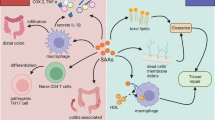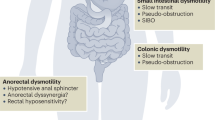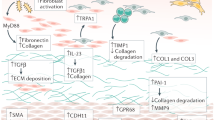Abstract
Systemic amyloidosis is characterized by the extracellular deposition of protein in an abnormal fibrillar form. Several different types of amyloidosis exist, each defined by the identity of their respective fibril precursor protein. Among patients with systemic amyloidosis, histological involvement of the gastrointestinal tract is very common but is often subclinical. Conversely, primary diseases of the gastrointestinal tract can cause systemic amyloidosis; for example, AA amyloidosis can occur secondary to IBD. The presence and pattern of gastrointestinal symptoms varies substantially, not only between the different types of amyloidosis but also within them. Typical clinical presentations, most of which are nonspecific, include macroglossia, hemorrhage, motility disorders, disturbance of bowel habit and malabsorption. Endoscopic and radiological features are also nonspecific, with the small intestine most commonly affected. Currently, the aim of therapy for amyloidosis is to slow amyloid formation by reducing the abundance of the fibril precursor protein. No specific treatments for the gastrointestinal symptoms of systemic amyloidosis are available; however, case reports and small published series encourage nutritional support for patients with motility disorders and pharmacological agents for treatment of diarrhea. Surgical procedures should be contemplated only in an emergency setting because of the risk of decompensation of organs affected by amyloid deposition.
Key Points
-
Amyloidosis is a multisystem disease caused by extracellular deposition of protein in an abnormal fibrillar form
-
Gastrointestinal manifestations and malnutrition are common and multifactorial in etiology and have a negative impact on quality of life and survival
-
Endoscopic and radiological features of gastrointestinal amyloid deposition are nonspecific
-
Treatment of amyloidosis aims to reduce the abundance of the respective precursor protein that forms amyloid fibrils (for example, administration of anti-inflammatory drugs, chemotherapy or liver transplantation)
-
Intensive nutritional support and nonspecific supportive measures are recommended for gastrointestinal complications
This is a preview of subscription content, access via your institution
Access options
Subscribe to this journal
Receive 12 print issues and online access
$209.00 per year
only $17.42 per issue
Buy this article
- Purchase on Springer Link
- Instant access to full article PDF
Prices may be subject to local taxes which are calculated during checkout




Similar content being viewed by others
References
Pepys, M. B. Amyloidosis. Annu. Rev. Med. 57, 223–241 (2006).
Pepys, M. B. Pathogenesis, diagnosis and treatment of systemic amyloidosis. Philos. Trans. R. Soc. Lond. B. Biol. Sci. 356, 203–210 (2001).
Kyle, R. A. & Gertz, M. A. Primary systemic amyloidosis: clinical and laboratory features in 474 cases. Semin. Hematol. 32, 45–59 (1995).
Dubrey, S. W. et al. The clinical features of immunoglobulin light-chain (AL) amyloidosis with heart involvement. QJM 91, 141–157 (1998).
Park, M. A. et al. Primary (AL) hepatic amyloidosis: clinical features and natural history in 98 patients. Medicine (Baltimore) 82, 291–298 (2003).
Gillmore, J. D., Lovat, L. B., Persey, M. R., Pepys, M. B. & Hawkins, P. N. Amyloid load and clinical outcome in AA amyloidosis in relation to circulating concentration of serum amyloid A protein. Lancet 358, 24–29 (2001).
Gertz, M. A. & Kyle, R. A. Secondary systemic amyloidosis: response and survival in 64 patients. Medicine (Baltimore) 70, 246–256 (1991).
Lovat, L. B., Persey, M. R., Madhoo, S., Pepys, M. B. & Hawkins, P. N. The liver in systemic amyloidosis: insights from 123I serum amyloid P component scintigraphy in 484 patients. Gut 42, 727–734 (1998).
Lachmann, H. J. et al. Natural history and outcome in systemic AA amyloidosis. N. Engl. J. Med. 356, 2361–2371 (2007).
Suhr, O., Danielsson, A., Holmgren, G. & Steen, L. Malnutrition and gastrointestinal dysfunction as prognostic factors for survival in familial amyloidotic polyneuropathy. J. Intern. Med. 235, 479–485 (1994).
Westermark, P., Sletten, K., Johansson, B. & Cornwell, G. G. 3rd. Fibril in senile systemic amyloidosis is derived from normal transthyretin. Proc. Natl Acad. Sci. USA 87, 2843–2845 (1990).
Matsutani, H. et al. Vascular amyloid of unknown origin and senile transthyretin amyloid in the lung and gastrointestinal tract of old age: histological and immunohistochemical studies. Pathol. Int. 51, 326–332 (2001).
Prokaeva, T. et al. Soft tissue, joint and bone manifestations of AL amyloidosis: clinical presentation, molecular features and survival. Arthritis Rheum. 56, 3858–3868 (2007).
Gogel, H. K., Searles, R. P., Volpicelli, N. A. & Cornwell, G. G. 3rd. Primary amyloidosis presenting as Sjögren's syndrome. Arch. Intern. Med. 143, 2325–2326 (1983).
Khan, G. A., Lewis, F. I. & Dasgupta, M. β2-microglobulin amyloidosis presenting as esophageal perforation in a hemodialysis patient. Am. J. Nephrol. 17, 524–527 (1997).
Rubinow, A., Burakoff, R. & Cohen, A. S. & Harris, L. D. Esophageal manometry in systemic amyloidosis: a study of 30 patients. Am. J. Med. 75, 951–956 (1983).
Bjerle, P., Ek, B., Linderholm, H. & Steen, L. Oesophageal dysfunction in familial amyloidosis with polyneuropathy. Clin. Physiol. 13, 57–69 (1993).
Battle, W. M., Rubin, M. R., Cohen, S. & Snape, W. J. Jr. Gastrointestinal-motility dysfunction in amyloidosis. N. Engl. J. Med. 301, 24–25 (1979).
Melkebeke, P., Vandepitte, J., Hannon, R. & Fevery, J. Huge hepatomegaly, jaundice and portal hypertension due to amyloidosis of the liver. Digestion 20, 351–357 (1980).
Menke, D. M. et al. Symptomatic gastric amyloidosis in patients with primary systemic amyloidosis. Mayo Clin. Proc. 68, 763–767 (1993).
Youssef, N. et al. Fatal Dieulafoy's type ulcer in a case of AL amyloidosis [French]. Ann. Pathol. 24, 256–258 (2004).
Muraki, M. et al. Laceration of gastric mucosa associated with dialysis-related amyloidosis. Clin. Nephrol. 64, 448–451 (2005).
Hizawa, K. et al. Endoscopic hydrostatic balloon dilatation of ulcer-induced pyloric stenosis in rheumatoid arthritis and secondary amyloidosis. Surg. Endosc. 11, 673–675 (1997).
Suhr, O. B., Anan, I., Ahlström, K. R. & Rydh, A. Gastric emptying before and after liver transplantation for familial amyloidotic polyneuropathy: Portugese type (Val30Met). Amyloid 10, 121–126 (2003).
Saglam, F. et al. A renal transplant recipient with delayed gastric emptying in amyloidosis due to familial Mediterranean fever improved with erythromycin: a case report. Transplant. Proc. 40, 308–309 (2008).
Gilat, T. & Spiro, H. M. Amyloidosis and the gut. Am. J. Dig. Dis. 13, 619–633 (1968).
Yoshimatsu, S. et al. Endoscopic and pathological manifestations of the gastrointestinal tract in familial amyloidotic polyneuropathy type I (Met30). J. Intern. Med. 243, 65–72 (1998).
El-Salhy, M., Suhr, O., Stenling, R., Wilander, E. & Grimelius, L. Impact of familial amyloid associated polyneuropathy on duodenal endocrine cells. Gut 35, 1413–1418 (1994).
Matsumoto, T. et al. Breath hydrogen test using water-diluted lactulose in patients with gastrointestinal amyloidosis. Dig. Dis. Sci. 36, 1756–1760 (1991).
Feurle, G. E. Pathophysiology of diarrhea in patients with familial amyloid neuropathy. Digestion 36, 13–17 (1987).
Suhr, O., Danielsson, A. & Steen, L. Bile acid malabsorption caused by gastrointestinal motility dysfunction? An investigation of gastrointestinal disturbances in familial amyloidosis with polyneuropathy. Scand. J. Gastroenterol. 27, 201–207 (1992).
Guirl, M. J. et al. Rapid intestinal transit as a primary cause of severe chronic diarrhea in patients with amyloidosis. Am. J. Gastroenterol. 98, 2219–2225 (2003).
Hayman, S. R., Lacy, M. Q., Kyle, R. A. & Gertz, M. A. Primary systemic amyloidosis: a cause of malabsorption syndrome. Am. J. Med. 111, 535–540 (2001).
Steen, L. & Ek, B. Familial amyloidosis with polyneuropathy: a long term follow up of 21 patients with special reference to gastrointestinal symptoms. Acta Med. Scand. 214, 387–397 (1983).
Kawaguchi, M., Koizumi, F., Shimao, M. & Hirose, S. Protein-losing enteropathy due to secondary amyloidosis of the gastrointestinal tract. Acta Pathol. Jpn 43, 333–339 (1993).
Chang, H. S. et al. Massive small bowel bleeding in a patient with amyloidosis. Gastrointest. Endosc. 59, 126–129 (2004).
Mallory, A., Struthers, J. E. Jr & Kern, F. Jr. Persistent hypotension and intestinal infarction in a patient with primary amyloidosis. Gastroenterology 68, 1587–1592 (1975).
Rapoport, M., Yona, R., Kaufman, S., Segal, M. & Kornberg, A. Unusual bleeding manifestations of amyloidosis in patients with multiple myeloma. Clin. Lab. Haematol. 16, 349–353 (1994).
Yood, R. A., Skinner, M., Rubinow, A., Talarico, L. & Cohen, A. S. Bleeding manifestations in 100 patients with amyloidosis. JAMA 249, 1322–1324 (1983).
Caccialanza, R. et al. Nutritional status of outpatients with systemic immunoglobulin light-chain amyloidosis. Am. J. Clin. Nutr. 83, 350–354 (2006).
Ito, T. et al. Mechanism of constipation in familial amyloid polyneuropathy: a case report. Intern. Med. 45, 1173–1175 (2006).
El-Salhy, M. & Suhr, O. Endocrine cells in rectal biopsy specimens from patients with familial amyloidotic polyneuropathy. Scand. J. Gastroenterol. 31, 68–73 (1996).
Tada, S., Iida, M., Yao, T., Kitamoto, T., Yao, T. & Fujishima, M. Intestinal pseudo-obstruction in patients with amyloidosis: clinicopathologic differences between chemical types of amyloid protein. Gut 34, 1412–1417 (1993).
Greenstein, A. J. et al. Amyloidosis and inflammatory bowel disease: a 50 year experience with 25 patients. Medicine (Baltimore) 71, 261–270 (1992).
Wester, A. L., Vatn, M. H. & Fausa, O. Secondary amyloidosis in inflammatory bowel disease: a study of 18 patients admitted to Rikshospitalet University Hospital, Oslo, from 1962–1998. Inflamm. Bowel Dis. 7, 295–300 (2001).
Puchtler, H., Sweat, F. & Levine, M. On the binding of Congo red by amyloid. J. Histochem. Cytochem. 10, 355–364 (1962).
Lachmann, H. J. et al. Misdiagnosis of hereditary amyloidosis as AL (primary) amyloidosis. N. Engl. J. Med. 346, 1786–1791 (2002).
Hawkins, P. N. Studies with radiolabelled serum amyloid P component provide evidence for turnover and regression of amyloid deposits in vivo. Clin. Sci. (Lond.) 87, 289–295 (1994).
Tada, S. et al. Endoscopic and biopsy findings of the upper digestive tract in patients with amyloidosis. Gastrointest. Endosc. 36, 10–14 (1990).
Ebert, E. C. & Nagar, M. Gastrointestinal manifestations of amyloidosis. Am. J. Gastroenterol. 103, 776–787 (2008).
Yamada, M., Hatakeyama, S. & Tsukagoshi, H. Gastrointestinal amyloid deposition in AL (primary or myeloma-associated) and AA (secondary) amyloidosis: diagnostic value of gastric biopsy. Hum. Pathol. 16, 1206–1211 (1985).
Tada, S. et al. Endoscopic features in amyloidosis of the small intestine: clinical and morphologic differences between chemical types of amyloid protein. Gastrointest. Endosc. 40, 45–50 (1994).
Michael, H. et al. Congo-red negative colonic amyloid with scalloping of the valvulae conniventes. Gastrointest. Endosc. 53, 653–655 (2001).
Pollack, M. J. & Isenberg, G. A. Isolated small bowel amyloidosis seen with capsule endoscopy. Gastrointest. Endosc. 66, 829–830 (2007).
Dray, X. et al. Hemorrhagic bullous colitis as a primary manifestation of AL amyloidosis. Endoscopy 38, E15–E16 (2006).
Schmidt, H., Frühmorgen, P., Riemann, J. F. & Becker, V. Mucosal suggillation in the colon in secondary amyloidosis. Endoscopy 13, 181–183 (1981).
Hui, Y. T., Lam, T. W., Yee Lam, P. W., Yan Wu, W. H. & Lam, W. M. Narrow-band imaging system with magnifying endoscopy for rectal amyloidosis. Gastrointest. Endosc. 68, 400–401 (2008).
Tada, S. et al. Gastrointestinal amyloidosis: radiologic features by chemical types. Radiology 190, 37–42 (1994).
Kala, Z., Válek, V. & Kysela, P. Amyloidosis of the small intestine. Eur. J. Radiol. 63, 105–109 (2007).
Goulding, C., O'Hanlon, D. M., Clarke, E., Kennedy, M. & Lennon, J. Primary amyloidosis of the stomach: EUS appearances. Gastrointest. Endosc. 56, 305–306 (2002).
Trinh, T. D., Jones, B. & Fishman, E. K. Amyloidosis of the colon presenting as ischemic colitis: a case report and review of the literature. Gastrointest. Radiol. 16, 133–136 (1991).
Araoz, P. A., Batts, K. P. & MacCarty, R. L. Amyloidosis of the alimentary canal: radiologic–pathologic correlation of CT findings. Abdom. Imaging 25, 38–44 (2000).
Gandolfi, L. et al. Endoscopic ultrasonography in the diagnosis of gastrointestinal amyloid deposits: clinical case report. Endoscopy 27, 132–134 (1995).
Wechalekar, A. D., Hawkins, P. N. & Gillmore, J. D. Perspectives in treatment of AL amyloidosis. Br. J. Haematol. 140, 365–377 (2008).
Holmgren, G. et al. Clinical improvement and amyloid regression after liver transplantation in hereditary transthyretin amyloidosis. Lancet 341, 1113–1116 (1993).
Tan, S. Y. et al. Long term effect of renal transplantation on dialysis-related amyloid deposits and symptomatology. Kidney Int. 50, 282–289 (1996).
Amemori, S. et al. Oral dimethyl sulfoxide for systemic amyloid A amyloidosis complication in chronic inflammatory disease: a retrospective patient chart review. J. Gastroenterol. 41, 444–449 (2006).
Fushimi, T. et al. Severe protein losing enteropathy with intractable diarrhea due to systemic AA amyloidosis, successfully treated with corticosteroid and octreotide. Amyloid 12, 48–53 (2005).
Okuda, Y. & Takasugi, K. Successful use of humanized anti-interleukin-6 receptor antibody, tocilizumab, to treat amyloid A amyloidosis complicating juvenile idiopathic arthritis. Arthritis Rheum. 54, 2997–3000 (2006).
Maeshima, E., Yamada, Y. & Yukawa, S. Massive gastrointestinal hemorrhage in a case of amyloidosis secondary to rheumatoid arthritis. Scand. J. Rheumatol. 28, 262–264 (1999).
Costigan, D. J. & Clouse, R. E. Achalasia-like esophagus from amyloidosis. Successful treatment with pneumatic bag dilatation. Dig. Dis. Sci. 28, 763–765 (1983).
Reddy, A. B., Wright, R. A., Wheeler, G. E. & Nazer, H. Nonobstructive gastroparesis in amyloidosis with metoclopramide. Arch. Intern. Med. 143, 247–248 (1983).
Mardinger, O., Rotenberg, l., Chaushu, G. & Taicher, S. Surgical management of macroglossia due to primary amyloidosis. Int. J. Oral Maxillofac. Surg. 28, 129–131 (1999).
Johnson, D. H., Guthrie, T. H., Tedesco, F. J., Griffin, J. W. & Anthony, H. F. Jr. Amyloidosis masquerading as inflammatory bowel disease with a mass lesion stimulating a malignancy. Am. J. Gastroenterol. 77, 141–145 (1982).
Herlenius, G., Wilczek, H. E., Larsson, M. & Ericzon, B. G. Ten years of international experience with liver transplantation for familial amyloidotic polyneuropathy: results from the Familial Amyloidotic Polyneuropathy World Transplant Registry. Transplantation 77, 64–71 (2004).
Suhr, O. et al. Impact of gastrointestinal dysfunction on survival after liver transplantation for familial amyloidotic polyneuropathy. Dig. Dis. Sci. 41, 1909–1114 (1996).
Lång, K., Wikström, L., Danielsson, A., Tashima, K. & Suhr, O. B. Outcome of gastrointestinal complications after liver transplantation for familial amyloidotic polyneuropathy. Scand. J. Gastroenterol. 35, 985–989 (2000).
Pepys, M. B. et al. Targeted pharmacological depletion of serum amyloid P component for treatment of human amyloidosis. Nature 417, 254–259 (2002).
Pepys, M. B. in Amyloid and Amyloidosis (eds Grateau, G. et al.) 488–490 (CRC, Boca Raton, 2005).
Pepys, M. B. Science and serendipity. Clin. Med. 7, 562–578 (2007).
Author information
Authors and Affiliations
Corresponding author
Ethics declarations
Competing interests
The authors declare no competing financial interests.
Rights and permissions
About this article
Cite this article
Sattianayagam, P., Hawkins, P. & Gillmore, J. Systemic amyloidosis and the gastrointestinal tract. Nat Rev Gastroenterol Hepatol 6, 608–617 (2009). https://doi.org/10.1038/nrgastro.2009.147
Published:
Issue Date:
DOI: https://doi.org/10.1038/nrgastro.2009.147
This article is cited by
-
Primary localized ileal amyloidosis with chronic ileitis: a case report with review of literature
The Egyptian Journal of Internal Medicine (2023)
-
Colonic Amyloidosis
Journal of Gastrointestinal Surgery (2023)
-
A case report of gastric amyloidosis due to multiple myeloma mimicking gastric cancer
BMC Gastroenterology (2020)
-
Colonic Perforation as Initial Presentation of Amyloid Disease: Case Report and Literature Review
Digestive Diseases and Sciences (2020)
-
Gastric AA amyloidosis secondary to chronic infection presenting with hematemesis: a case report
Clinical Journal of Gastroenterology (2020)



